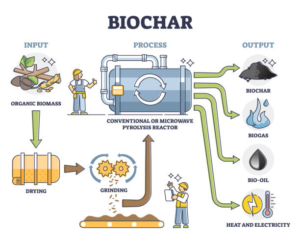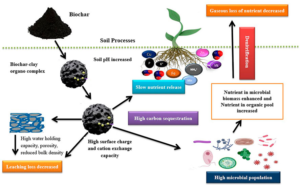Source of Picture: Arbor Hills Tree Farm
Most people think charcoal is only meant for use in a BBQ. But there is a version of charcoal called biochar that helps with sustainability. Biochar is used to improve soil quality, sequester carbon, and enhance agricultural productivity. And, as exotic as it sounds, you can buy it from your local hardware store or garden center.
What is biochar?
Biochar is a stable solid, rich in carbon made from organic waste material or biomass that is partially combusted in the presence of limited oxygen. The qualities that make up biochar vary depending upon the material that it comes from (feedstocks such as timber slash, corn stalks, manure, etc.). Biochar is produced through the pyrolysis of biomass, such as agricultural and forestry waste. Pyrolysis is a process where organic materials are heated in the absence of oxygen, leading to the decomposition of the material into biochar, gases, and liquid bio-oil. The resulting biochar is a stable form of carbon that can be used as a soil amendment.

Source of Graphic: Getty Images
Although biochar is a type of charcoal, you would not use it for your backyard grill. It’s more porous and has a larger surface area than charcoal, which helps it improve soil structure and house beneficial microbes. Biochar is produced under more controlled circumstances than charcoal. Note that some biochar and gardening websites state that charcoal cannot be used as biochar for soil.
What are the benefits and challenges of using biochar?
Biochar is known for its potential benefits in agriculture and environmental sustainability. When incorporated into soil, biochar can improve soil fertility, water retention, and nutrient availability. It also can sequester carbon, helping to mitigate climate change by locking carbon in a stable form.

Source of Graphic: Frontiers in Environmental Science
In addition to its agricultural applications, biochar is also being explored for water treatment, as a component in animal feed, and in various industrial processes. The production of biochar can vary in scale, from small-scale systems for individual farmers to larger industrial processes.
Among some of the concerns is the environmental impact from diverting land for biochar and the energy footprint of production and transportation involved with the complete supply chain from feedstock to soil. Depending upon its feedstock and its production conditions, biochar could be a source of contamination by containing polyaromatic hydrocarbons (PAHs), dioxins, VOCs, and heavy metals. Considering this concern, the National Resources Defense Council has said that using waste biomass, such as plant residue or manure, looks like the most promising and safe feedstock for biochar.
You may be wondering how biochar differs from enhanced weathering (EW). After all, the use and benefits of biochar are like those of EW. However, biochar and EW differ in how they are sourced. Biochar is made from biomass while EW is made from finely ground silicate rocks. Read this article for more details on EW.
Biochar and The Conservation Foundation
The Conservation Foundation’s mission is to improve the health of our communities by preserving and restoring natural areas and open space, protecting rivers and watersheds, and promoting stewardship of our environment. In that regard, our efforts help mitigate climate change.
The Conservation Foundation is a leader in sustainable farming. On its own McDonald Farm in Naperville, Illinois, The Conservation Foundation uses organic farming land-management practices to improve soil health, biodiversity, and climate resilience.
The Conservation Foundation is a recognized expert and reasoned voice on conservation issues and, with the help of its members and donors, provides the leadership required to achieve this vision. The Conservation Foundation provides a forum for the discussion of ideas – even those we may not 100% support or are still in the “too early to say” stage. It’s always good to be aware of emerging technologies.
By all accounts, the use of biochar produced from the proper feedstock is safe for food and has no human health effects. It is available at Home Depot, Amazon, Meijer, Walmart, and other online and local and garden stores. As previously noted, there are concerns about the costs and climate effects of the production and transportation involved. And profitability for farmers must be addressed. Production costs, feedstock availability, transportation costs, how it is applied, market demand, and government policies and incentives all factor into whether biochar can be implemented at scale for agriculture.
Land conservation and biochar are both addressing the problem of climate change. They are two parts of an overall strategy to mitigate the negative impacts of climate change, create healthier communities, and improve the resiliency of ecosystems. As biochar practices develop, it may have the potential to address climate change.
Ready to support conservation and maybe even use a little biochar? Well, conservation is what The Conservation Foundation has been doing every day for more than 50 years. We can all do more together than we can alone. Join our collective momentum – become a member today!
Feel free to comment on this blog with your ideas on biochar.
By Steve Stawarz, Oak Brook
DuPage County Advisory Council Member



